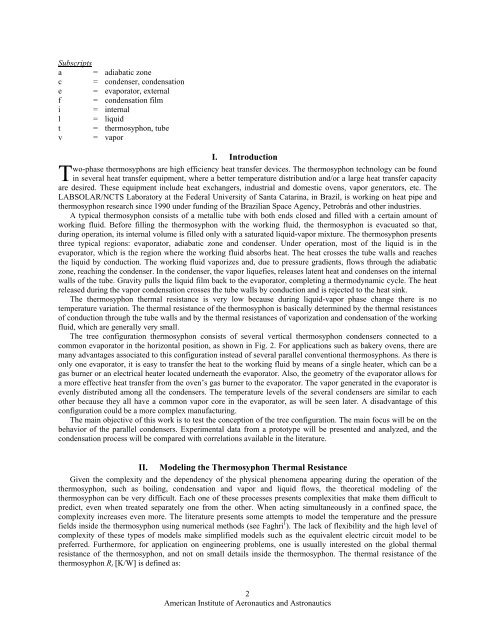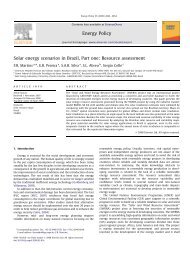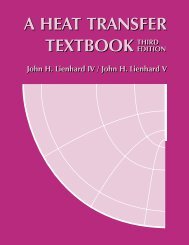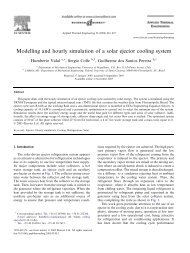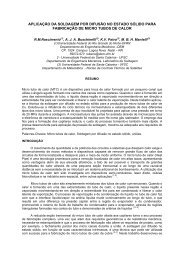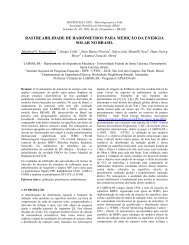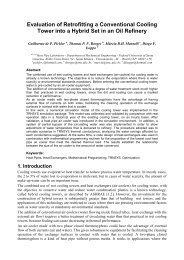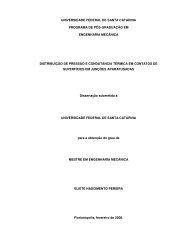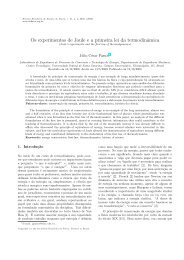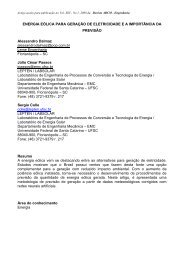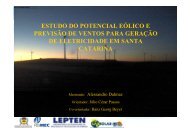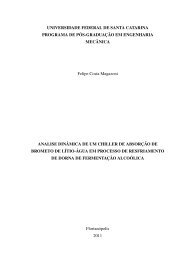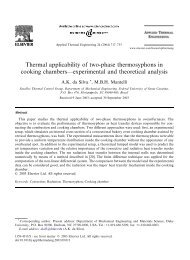Tree Configuration Thermosyphon Study - LEPTEN
Tree Configuration Thermosyphon Study - LEPTEN
Tree Configuration Thermosyphon Study - LEPTEN
You also want an ePaper? Increase the reach of your titles
YUMPU automatically turns print PDFs into web optimized ePapers that Google loves.
Subscripts<br />
a = adiabatic zone<br />
c = condenser, condensation<br />
e = evaporator, external<br />
f = condensation film<br />
i = internal<br />
l = liquid<br />
t = thermosyphon, tube<br />
v = vapor<br />
I. Introduction<br />
wo-phase thermosyphons are high efficiency heat transfer devices. The thermosyphon technology can be found<br />
T in several heat transfer equipment, where a better temperature distribution and/or a large heat transfer capacity<br />
are desired. These equipment include heat exchangers, industrial and domestic ovens, vapor generators, etc. The<br />
LABSOLAR/NCTS Laboratory at the Federal University of Santa Catarina, in Brazil, is working on heat pipe and<br />
thermosyphon research since 1990 under funding of the Brazilian Space Agency, Petrobrás and other industries.<br />
A typical thermosyphon consists of a metallic tube with both ends closed and filled with a certain amount of<br />
working fluid. Before filling the thermosyphon with the working fluid, the thermosyphon is evacuated so that,<br />
during operation, its internal volume is filled only with a saturated liquid-vapor mixture. The thermosyphon presents<br />
three typical regions: evaporator, adiabatic zone and condenser. Under operation, most of the liquid is in the<br />
evaporator, which is the region where the working fluid absorbs heat. The heat crosses the tube walls and reaches<br />
the liquid by conduction. The working fluid vaporizes and, due to pressure gradients, flows through the adiabatic<br />
zone, reaching the condenser. In the condenser, the vapor liquefies, releases latent heat and condenses on the internal<br />
walls of the tube. Gravity pulls the liquid film back to the evaporator, completing a thermodynamic cycle. The heat<br />
released during the vapor condensation crosses the tube walls by conduction and is rejected to the heat sink.<br />
The thermosyphon thermal resistance is very low because during liquid-vapor phase change there is no<br />
temperature variation. The thermal resistance of the thermosyphon is basically determined by the thermal resistances<br />
of conduction through the tube walls and by the thermal resistances of vaporization and condensation of the working<br />
fluid, which are generally very small.<br />
The tree configuration thermosyphon consists of several vertical thermosyphon condensers connected to a<br />
common evaporator in the horizontal position, as shown in Fig. 2. For applications such as bakery ovens, there are<br />
many advantages associated to this configuration instead of several parallel conventional thermosyphons. As there is<br />
only one evaporator, it is easy to transfer the heat to the working fluid by means of a single heater, which can be a<br />
gas burner or an electrical heater located underneath the evaporator. Also, the geometry of the evaporator allows for<br />
a more effective heat transfer from the oven’s gas burner to the evaporator. The vapor generated in the evaporator is<br />
evenly distributed among all the condensers. The temperature levels of the several condensers are similar to each<br />
other because they all have a common vapor core in the evaporator, as will be seen later. A disadvantage of this<br />
configuration could be a more complex manufacturing.<br />
The main objective of this work is to test the conception of the tree configuration. The main focus will be on the<br />
behavior of the parallel condensers. Experimental data from a prototype will be presented and analyzed, and the<br />
condensation process will be compared with correlations available in the literature.<br />
II. Modeling the <strong>Thermosyphon</strong> Thermal Resistance<br />
Given the complexity and the dependency of the physical phenomena appearing during the operation of the<br />
thermosyphon, such as boiling, condensation and vapor and liquid flows, the theoretical modeling of the<br />
thermosyphon can be very difficult. Each one of these processes presents complexities that make them difficult to<br />
predict, even when treated separately one from the other. When acting simultaneously in a confined space, the<br />
complexity increases even more. The literature presents some attempts to model the temperature and the pressure<br />
fields inside the thermosyphon using numerical methods (see Faghri 1 ). The lack of flexibility and the high level of<br />
complexity of these types of models make simplified models such as the equivalent electric circuit model to be<br />
preferred. Furthermore, for application on engineering problems, one is usually interested on the global thermal<br />
resistance of the thermosyphon, and not on small details inside the thermosyphon. The thermal resistance of the<br />
thermosyphon R t [K/W] is defined as:<br />
2<br />
American Institute of Aeronautics and Astronautics


